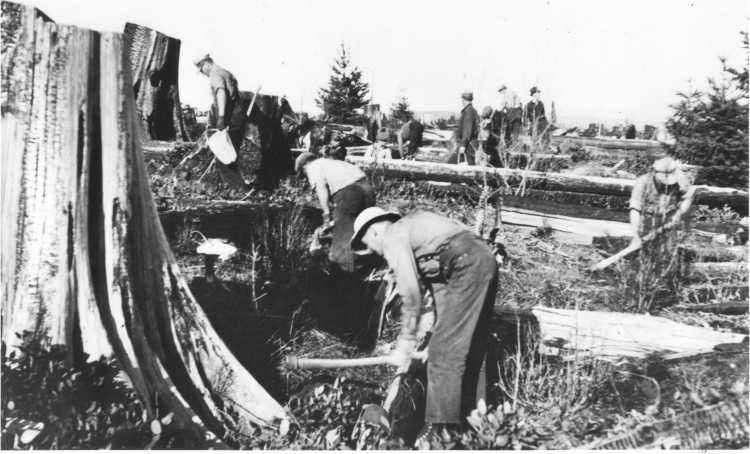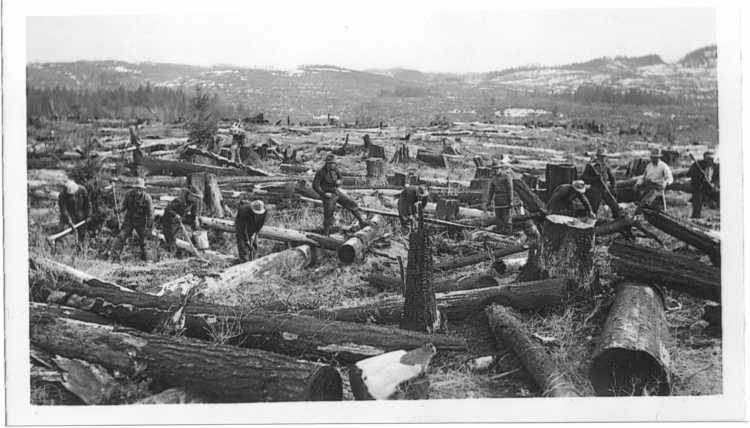Page
1 | Page 2 | Page
3 | Back to Work Page
Most
people today understand the need to respect our environment. In
the past, however, people either didn't know or didn't care about
the harmful effects of pollution and resource exploitation. Today,
however, most people agree that it is better to recycle a can than
to throw it in the garbage and that is better to replant trees instead
of cutting them down and leaving an empty field.
Trees
are a renewable resource. There is a limited amount of coal and
gas in the world, but you can always plant more trees. But forests
need to be carefully managed for them to survive. In Canada, 700
million trees are planted every year. Sixty years ago, however,
not only would planting that many trees would have seemed impossible,
but people might not have even thought that it was necessary.
During
the Second World War, Canada's conscientious objectors were part
of a tree-planting program. One of their biggest accomplishments
was planting 17 million trees on Vancouver Island and reviving the
burnt-out Sayward Forest near Campbell River.
Read
some articles about tree planting from The Beacon, the
CO newspaper, and watch some videos. The first video shows what
the tree nursery looked like, and the second one shows a close-up
of the seedlings.
Article
1 |  |
|  | Article 2
| Article 2
Gordon
Dyck worked as a tree planter. He describes the history of the forest
and some of the obstacles the COs faced.
“As
the logging method had been extremely wasteful, taking out only
the best and convenient trees, the area was left with a great
number of trees killed by the fire, that needed to be cut down
to be able to control future fires. A dead and partly rotten standing
tree, called a “snag,” was considered a great fire hazard, as
the fire would run up and the wind could then blow burning embers
a considerable distance. So during the winter we cut them down
and left them where they fell. Then in the cooler seasons of spring
and fall, we planted seedling trees in these areas, right among
the felled snag. Occasionally where loggers had taken nothing,
these dead trees now lay crisscross in a six to eight foot layer.
We simply walked on top of this mess and jumped down here and
there to plant a tree. We wore special loggers' boots called caulk
boots, with soles covered with short spikes. Every store in town
had a sign prohibiting wearing them inside. The damage done to
our bunk house floors was considerable.
“Each
tree planting crew consisted of about 15 men spaced about 6 feet
[1.8 m] apart. The area had been surveyed and so the end men had
to keep a sharp lookout for the stakes and the rest of us in the
line just kept about 2 paces from our neighbour. The seedlings
were strategically placed in beds ahead of time, and we never
seemed to run out. We were always able to re-supply our burlap
shoulder bags in time. The trees we planted were all Douglas Fir
and came in bundles of 100, about 12 inches [30 cm] long. Each
of us had a mattock (a heavy tool similar to a hoe) with a 4 foot
[1.2 m] handle."

 David Jantzi explains
the method trees were planted.
David Jantzi explains
the method trees were planted.
"We
would chop into the ground, pull a little, slip a seedling in
behind the blade and then pack it down by stepping beside the
seedling as we took two more steps to plant the next one."
 |
 |
| Planting trees in a burned out area. |
Planting trees on Vancouver Island after snags have been
cut down. |
“We
learned to do this quite rapidly, hardly even stopping – just
chop and plant, chop and plant. Soon our straw boss, Pete Unger,
would call out “Take five!” meaning a five minute rest. The reason
for these many rest stops was that the forest service would not
permit a man to plant more than 1000 trees a day, since they felt
that at that speed, the seedlings were just being thrown away.
But the work was supposed to last all day, hence the many “Take
fives.” Actually we never threw trees away and could have easily
planted more, but “rules are rules.” So why complain. Having visited
these areas later in life, I was surprised to see the country
covered with forest. It seems they all grew.” [ASP, 59-60]
The
COs who return to Vancouver Island to look at where they worked
can hardly believe how tall the trees are. After sixty years,
these trees are reaching maturity. In 1995, Ed Janzen estimated
the value of these trees. He called up some lumberyards to find
out how much each of those trees was worth. They gave him a surprising
answer. The trees planted by the COs are now worth $1.75 billion.
Read his full story
in the “So What” section.
Page
1 | Page 2 | Page
3 | Back to Work Page
|


